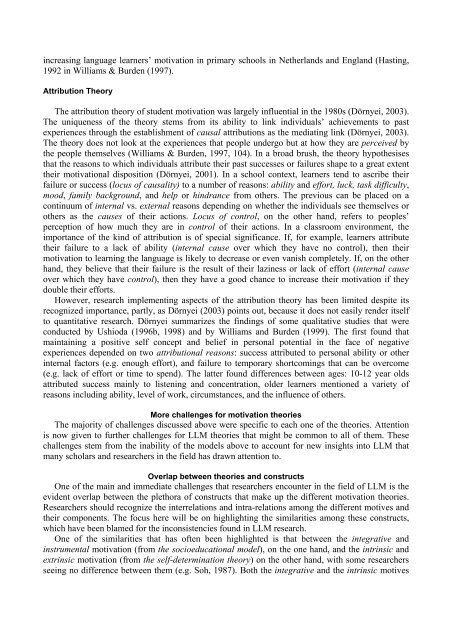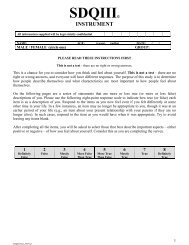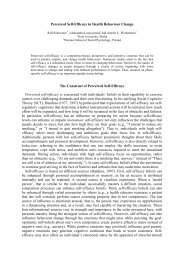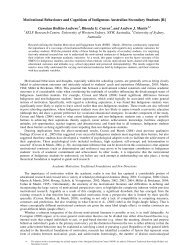A Critical Appraisal of Language Learning Motivation Theories Faris ...
A Critical Appraisal of Language Learning Motivation Theories Faris ...
A Critical Appraisal of Language Learning Motivation Theories Faris ...
Create successful ePaper yourself
Turn your PDF publications into a flip-book with our unique Google optimized e-Paper software.
increasing language learners’ motivation in primary schools in Netherlands and England (Hasting,<br />
1992 in Williams & Burden (1997).<br />
Attribution Theory<br />
The attribution theory <strong>of</strong> student motivation was largely influential in the 1980s (Dörnyei, 2003).<br />
The uniqueness <strong>of</strong> the theory stems from its ability to link individuals’ achievements to past<br />
experiences through the establishment <strong>of</strong> causal attributions as the mediating link (Dörnyei, 2003).<br />
The theory does not look at the experiences that people undergo but at how they are perceived by<br />
the people themselves (Williams & Burden, 1997, 104). In a broad brush, the theory hypothesises<br />
that the reasons to which individuals attribute their past successes or failures shape to a great extent<br />
their motivational disposition (Dörnyei, 2001). In a school context, learners tend to ascribe their<br />
failure or success (locus <strong>of</strong> causality) to a number <strong>of</strong> reasons: ability and effort, luck, task difficulty,<br />
mood, family background, and help or hindrance from others. The previous can be placed on a<br />
continuum <strong>of</strong> internal vs. external reasons depending on whether the individuals see themselves or<br />
others as the causes <strong>of</strong> their actions. Locus <strong>of</strong> control, on the other hand, refers to peoples’<br />
perception <strong>of</strong> how much they are in control <strong>of</strong> their actions. In a classroom environment, the<br />
importance <strong>of</strong> the kind <strong>of</strong> attribution is <strong>of</strong> special significance. If, for example, learners attribute<br />
their failure to a lack <strong>of</strong> ability (internal cause over which they have no control), then their<br />
motivation to learning the language is likely to decrease or even vanish completely. If, on the other<br />
hand, they believe that their failure is the result <strong>of</strong> their laziness or lack <strong>of</strong> effort (internal cause<br />
over which they have control), then they have a good chance to increase their motivation if they<br />
double their efforts.<br />
However, research implementing aspects <strong>of</strong> the attribution theory has been limited despite its<br />
recognized importance, partly, as Dörnyei (2003) points out, because it does not easily render itself<br />
to quantitative research. Dörnyei summarizes the findings <strong>of</strong> some qualitative studies that were<br />
conducted by Ushioda (1996b, 1998) and by Williams and Burden (1999). The first found that<br />
maintaining a positive self concept and belief in personal potential in the face <strong>of</strong> negative<br />
experiences depended on two attributional reasons: success attributed to personal ability or other<br />
internal factors (e.g. enough effort), and failure to temporary shortcomings that can be overcome<br />
(e.g. lack <strong>of</strong> effort or time to spend). The latter found differences between ages: 10-12 year olds<br />
attributed success mainly to listening and concentration, older learners mentioned a variety <strong>of</strong><br />
reasons including ability, level <strong>of</strong> work, circumstances, and the influence <strong>of</strong> others.<br />
More challenges for motivation theories<br />
The majority <strong>of</strong> challenges discussed above were specific to each one <strong>of</strong> the theories. Attention<br />
is now given to further challenges for LLM theories that might be common to all <strong>of</strong> them. These<br />
challenges stem from the inability <strong>of</strong> the models above to account for new insights into LLM that<br />
many scholars and researchers in the field has drawn attention to.<br />
Overlap between theories and constructs<br />
One <strong>of</strong> the main and immediate challenges that researchers encounter in the field <strong>of</strong> LLM is the<br />
evident overlap between the plethora <strong>of</strong> constructs that make up the different motivation theories.<br />
Researchers should recognize the interrelations and intra-relations among the different motives and<br />
their components. The focus here will be on highlighting the similarities among these constructs,<br />
which have been blamed for the inconsistencies found in LLM research.<br />
One <strong>of</strong> the similarities that has <strong>of</strong>ten been highlighted is that between the integrative and<br />
instrumental motivation (from the socioeducational model), on the one hand, and the intrinsic and<br />
extrinsic motivation (from the self-determination theory) on the other hand, with some researchers<br />
seeing no difference between them (e.g. Soh, 1987). Both the integrative and the intrinsic motives





